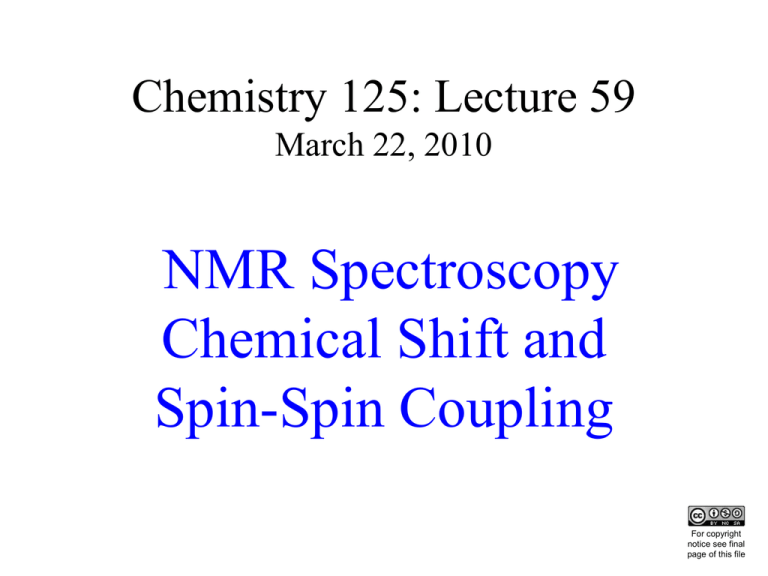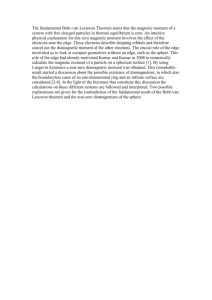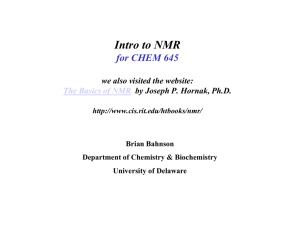
Chemistry 125: Lecture 59
March 22, 2010
NMR Spectroscopy
Chemical Shift and
Spin-Spin Coupling
This
For copyright
notice see final
page of this file
NMR:
locating protons
within molecules
using uniform field
?
Fractional
difference in
applied field
0.00000248 !
Listen at fixed frequency.
Tune H to “hear” precession.
2.48 ppm
Requires very high
uniformity of field
to avoid “MRI”
The “Chemical” Shift
HO-CH2-CH3
http://www.wooster.edu/chemistry/is/brubaker/nmr
H
Oscilliscope Trace
(1951)
Dr. Lauterbur became interested in possible biological
applications of nuclear magnetic resonance after reading a paper
in 1971 by Raymond V. Damadian, who described how some
cancerous tissues responded differently to the magnetic fields than
normal tissue.
Until then, most scientists placed the samples in a uniform
magnetic field, and the radio signals emanated from the entire
sample. Dr. Lauterbur realized that if a non-uniform magnetic field
were used, then the radio signals would come from just one slice
of the sample, allowing a two-dimensional image to be created.
i.e. one particular frequency
The nuclear magnetic resonance machine at SUNY was shared
among the chemistry professors, and the other professors needed
to perform their measurements in a uniform magnetic field. Dr.
Lauterbur had to conduct his work at night, returning the machine
to its original settings each morning.
Some of the
Magnetic Resonance
Spectrometers
in Yale's
have put classical
structure proof
Chemistry
Department
by
chemical transformation
(and even IR!) out of business.
One Yale “natural products” organic professor, whose
research used chemical transformations to determine
molecular structures, abandoned organic chemistry
to take up fundamental research on quantum theory
(and later became a professional studio photographer).
500 MHz
500 MHz
600 MHz
600 MHz
800 MHz
*
3
~8 = 512
times as
sensitive
as 100 MHz
(not to mention
the chemical
shift advantage
discussed below)
*
1) Boltzmann factor
2) Energy quantum
3) Electronics sensitivity
EPR (Electron Paramagnetic Resonance)
(for Free Radicals with SOMOs)
e magnet is 660x H+!
EPR (Electron Paramagnetic Resonance)
9 GHz
~3000 Gauss
(0.3 Tesla)
New 900 MHz (21 Tesla) NMR spectrometers
NHFML - Florida State University
Varian
Associates
NHFML now has a pulsed field NMR at 45 Tesla
(there is no charge for use, but you have to have a great experiment
Which peak is
which set of
protons?
1
2
Area
(integral)
3
HO-CH2-CH3
http://www.wooster.edu/chemistry/is/brubaker/nmr
number
of protons,
because
they are
so similar
(not like IR)
Oscilliscope Trace
(1951)
O
O
O
?
O
O
O
O
O
3:1
1:1
1) O3 2) H2O2
?
Structural proof
by chemical
HO-C
C-OH
degradation
1955
Advertisement
O O
cis-caronic
acid
(venerable)
C
H
2.9
1
H C
http://www.wooster.edu/chemistry/is/brubaker/nmr
Higher Resolution Shows Splitting
Advantage of “similarity” of protons
(unlike IR where various modes have very different changes
in dipole moment, and thus very different signal strengths)
1959
http://www.wooster.edu/chemistry/is/brubaker/nmr
Ethyl
Acetate
averages field
inhomogeneities
1959
A 90° pulse makes
spinning nuclei (1H, 13C)
“broadcast” a frequency
that tells their
LOCAL magnetic field.
Components of
Effective Magnetic Field.
Bmolecular (diamagnetic)
Applied Field:
Inhomogeneous ~ 30,000 G for MRI CAT scan.
(4 G/cm for humans, 50 G/cm for small animals)
Bapplied
Homogeneous for Chemical NMR Spectroscopy
Beffective
(spin sample)
Molecular Field:
Net electron orbiting - “Chemical Shift”
(Range ~12 ppm for 1H, ~ 200 ppm for 13C)
Nearby magnetic nuclei - “Spin-Spin Splitting”
(In solution JHH 0-30 Hz ; JCH 0-250 Hz)
Chemical Shift and Shielding
high
electron
density
Note: Electron orbiting to give B is driven by B; so B B.
CH3
Bmolecular (diamagnetic)
Si
H3C
CH3
H3C
CH3C
C-H
?
TMS
! ???
Bapplied
Beffective
deshielded
downfield
shielded
Cf. Table 15.4 p. 720
low e- density
high chemical shift
high frequency
upfield
high e- density
low chemical shift
low frequency
1/r3
Bapplied
PPM
Suppose molecule
undergoes
rotational averaging.
Electrons
Orbiting
Other
Nuclei
average
around
over
sphere
circle
ZERO!
Ignore
Diamagnetism
them!
from Orbiting
Electrons
Electrons
Orbiting
Other
Nuclei
Bapplied
average
over
sphere
NOT ZERO!
Diamagnetic
“Anisotropy”
(depends on direction)
Unless orbiting
depends on
molecular
orientation
Diamagnetic Anisotropy
Benzene “Ring Current”
B0 can only drive circulation about
a path to which it is perpendicular.
15.30
If the ring rotates so that it is
no longer perpendicular to B0,
the ring current stops.
Aromaticity: PMR Chemical Shift Criterion
?
14 electrons
(43 + 2)
TMS
DIAMAGNETIC
electrons
ANISOTROPY 10 (distorted)
HCCl3
8H
TMS
DIAMAGNETIC
ANISOTROPY!
2H
-4.23
Diamagnetic Anisotropy
Acetylene “Ring Current”
15.32
The H nuclei of acetylene
lie on the orbital axis
when there is ring current.
(B0 diminshed;
Warning!
signal shifts upfield).
This handy picture of
diamagnetic
The H nucleianisotropy
of benzene
due to ring
lie outside
the current
orbital path
may there
well be
nonsense!
when
is ring
current.
(B0 augmented;
(Prof. Wiberg
showed it to
signal
shifts downfield).
be nonsense
for 13C.)
Spin-Spin Splitting
Three peaks from
four different sets of
15.36.jpg
molecules in the sample.
~1:2:1 Triplet
15.37.jpg
~1:3:3:1 Quartet
Isotropic JH-H
is mediated by
bonding electrons
(through-space part is anisotropic,
averaged to zero by tumbling)
End of Lecture 59
March 22, 2010
Copyright © J. M. McBride 2010. Some rights reserved. Except for cited third-party materials, and those used by visiting
speakers, all content is licensed under a Creative Commons License (Attribution-NonCommercial-ShareAlike 3.0).
Use of this content constitutes your acceptance of the noted license and the terms and conditions of use.
Materials from Wikimedia Commons are denoted by the symbol
.
Third party materials may be subject to additional intellectual property notices, information, or restrictions.
The following attribution may be used when reusing material that is not identified as third-party content:
J. M. McBride, Chem 125. License: Creative Commons BY-NC-SA 3.0






